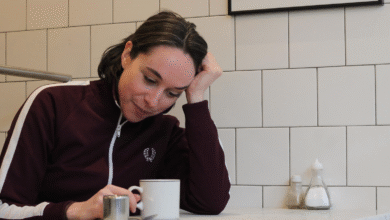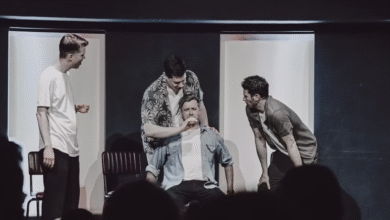A very enjoyable collection of shows with high production values. The depiction of technology failings is used to excellent dramatic effect. summary
Rating
Excellent
It doesn’t really need saying yet again, we all know how tough the last year has been for all kinds of creatives, and I’ll be straight back in the theatre there as soon as it’s safe. In the meantime, thank goodness for the likes of KickItDown Productions, a new company helping creatives get their ideas out there during the pandemic. They have masterminded the Lockdown Liftupsscheme which, during December, live-streamed 18 pieces of new writing created following a call out in March 2020. Digital Sharing is the result, six videos featuring three shows each.
Digital Sharing 2 features Catch It, Whiskey Wednesdays and Wallace. All three together only last twenty minutes but it’s a joy to dive into these stories for those brief moments. Although there’s a lot of ‘zoom theatre’ out there right now, the two shows with video (Wallace is an audio only performance) are incredibly well done.
In Catch It we meet a brother (Mark Nicolson) and sister (Miranda Heath), based on opposite sides of the world, with the tensions and upset that brings at any time, let alone during a pandemic. Mark and Miranda’s performances are entirely believable, at times moving and very reminiscent of a lot of family dramas. It was incredibly impressive how much of their lives and story are presented in such a short space of time. The use of ‘zoom theatre’ worked particularly well, filmed talking into their laptops from a distance rather than directly into camera. This worked well giving it a sense of professionalism that can be a challenge during lockdown.
Whiskey Wednesdays is a heart-breaking snapshot into the estranged relationship between a father (John Vernon) and daughter (Roberta Livingston). The show cleverly leaves out key details until the final showdown by breaking up the call quality – a frustration for us all over the last year but used with great dramatic effect here. As an audience we only hear little snippets, “you knew the truth” only for the line to break up. It’s not until further into the conversation that the truth is revealed to us. As well as using technology effectively, Whiskey Wednesdays is brilliantly written by Paige Cowan-Hall, getting across the frustrations of both father and daughter as he tries desperately to make amends.
Audio only show Wallace takes a different approach to the other two. The text appears on screen, but I would recommend turning the screen away so that you don’t just read it along with narrator Daniel Carlin. It’s the 2am ramblings of a man who shares with his sleeping partner some amusing anecdotes, such as eating pizza that wasn’t good enough for a fox, as well as some upsetting memories. Traumatic childhood experiences when he was caught wearing his mother’s clothes contrast with his partner who had a much easier time confronting his sexuality, implying he “came out the womb, wearing a scarf, reading vogue”. It makes you wonder why he has these conversations when his partner is asleep, the untold truths that he doesn’t want to share. Daniel is a fantastic narrator to this piece, and I could have listened to a lot more!
You would expect a high level of writing and performance from these Digital Sharing films, as they selected just eighteen from seven hundred submissions, and Digital Sharing 2 certainly delivers. Despite the short length of all three shows, they were engaging stories with believable characters. Overall, Digital Sharing 2 was a very enjoyable way to spend 20 minutes, and I will definitely be seeing what the others have to offer.
Catch It
Written by: Andy Chaplin
Directed by: Jamie Hogarth
Whiskey Wednesdays
Written by: Paige Cowan-Hall
Directed by: Kwame Owusu
Wallace
Written by: Jamie Bisping
Directed by: Toby Ashbourne
Produced by: KickItDown Productions
All six editions of Digital Sharing are available via KickItDown Production’s website below.







